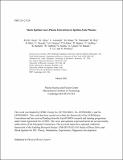Shock Ignition Laser-Plasma Interactions in Ignition-Scale Plasmas
Author(s)
Scott, R.H.H.; Glize, K.; Antonelli, L.; Khan, M.; Theobald, W.; Wei, M.; Betti, R.; Stoeckl, C.; Seaton, A.G.; Arber, T.D.; Barlow, D.; Goffrey, T.; Bennett, K.; Garbett, W.; Atzeni, S.; Casner, A.; Batani, D.; Li, Chi-Kang; Woolsey, N.; ... Show more Show less
Download21ja024_full.pdf (7.831Mb)
Metadata
Show full item recordAbstract
We use a subignition scale laser, the 30 kJ Omega, and a novel shallow-cone target to study laser-plasma interactions at the ablation-plasma density scale lengths and laser intensities anticipated for direct drive shock-ignition implosions at National Ignition Facility scale. Our results show that, under these conditions, the dominant instability is convective stimulated Raman scatter with experimental evidence of two plasmon decay (TPD) only when the density scale length is reduced. Particle-in-cell simulations indicate this is due to TPD being shifted to lower densities, removing the experimental back-scatter signature and reducing the hot-electron temperature. The experimental laser energy-coupling to hot electrons was found to be 1%– 2.5%, with electron temperatures between 35 and 45 keV. Radiation-hydrodynamics simulations employing these hot-electron characteristics indicate that they should not preheat the fuel in MJ-scale shock ignition experiments.
Description
Submitted for publication in Physical Review Letters
Date issued
2021-03Department
Massachusetts Institute of Technology. Plasma Science and Fusion CenterJournal
Physical Review Letters
Publisher
APS
Other identifiers
21ja024